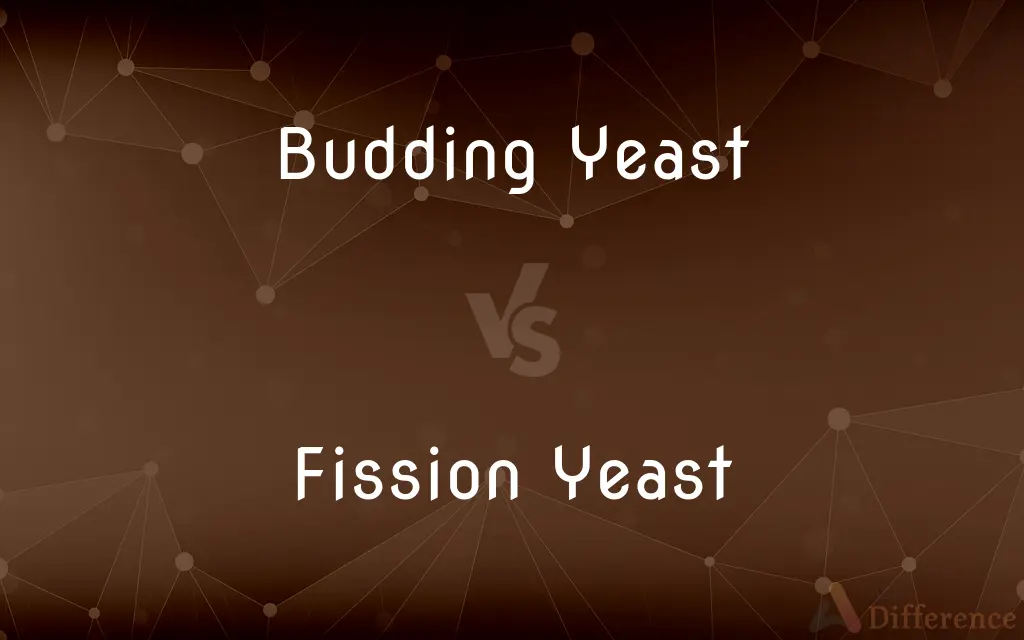Budding Yeast vs. Fission Yeast — What's the Difference?
By Tayyaba Rehman — Published on October 23, 2023
Budding Yeast reproduces by forming a bud which detaches, while Fission Yeast divides evenly into two daughter cells. Both are significant for biological research due to their distinct cellular division processes.

Difference Between Budding Yeast and Fission Yeast
Table of Contents
ADVERTISEMENT
Key Differences
In the scientific and research context, Budding Yeast serves as a paramount model organism, facilitating the understanding of cellular biology, genetics, and the cell cycle, owing to its unique budding and division processes. The asymmetrical cellular division in Budding Yeast provides rich insights into cellular aging and regeneration, as the parental cell can continue to produce new buds, extending its life cycle and enhancing its usability in longevity research and studies involving cellular vitality and rejuvenation.
Tayyaba Rehman
Oct 23, 2023
Moreover, in the practical application within biotechnological industries, Budding Yeast is predominantly employed in brewing, baking, and even in the production of biofuel, leveraging its robust fermentation capabilities and resilience in various environments. The capability of Budding Yeast to effectively ferment sugars into alcohol and carbon dioxide underpins its vital role in industries that hinge on fermentation processes and biotechnological applications that necessitate cellular stability and endurance.
Tayyaba Rehman
Oct 23, 2023
Conversely, Fission Yeast, through its symmetric division, becomes a pivotal research tool in exploring cellular dynamics, genetics, and also various aspects of cellular biology but through a different lens. The equitable division into two new cells offers insights into cellular biology where the emphasis is on maintaining cellular integrity, genetic consistency, and stability throughout the reproductive process, providing a stable and consistent model for exploring cellular development, growth, and division.
Tayyaba Rehman
Oct 23, 2023
Fission Yeast, whilst also used in research pertaining to cell biology and the cell cycle, may not be as widely utilized in industrial fermentation processes as Budding Yeast. Nonetheless, its contributions to the understanding of cellular mechanics, particularly the mechanisms underpinning symmetrical cellular division, genetic propagation, and cellular development, remain invaluable. Fission Yeast stands as a crucial model in comprehending the foundational aspects of cellular biology and genetics, thus fortifying its significance within the scientific community.
Tayyaba Rehman
Oct 23, 2023
In the realm of microbiology, the reproductive methods of yeasts, specifically Budding Yeast and Fission Yeast, have drawn substantial attention due to their contrasting mechanisms. Budding Yeast, scientifically termed Saccharomyces cerevisiae, undergoes a fascinating reproductive process where a small bud forms on the parent yeast cell, which eventually separates, becoming a new organism. This asymmetrical division yields a smaller daughter cell and the original parent cell, embodying a distinctive method of reproduction that leans on asymmetry and differential cellular growth.
Tayyaba Rehman
Oct 23, 2023
ADVERTISEMENT
Fission Yeast, recognized scientifically as Schizosaccharomyces pombe, exhibits a starkly different method of reproduction, entailing a cellular division process that results in two identical daughter cells. This occurs through a symmetrical cellular division, wherein the parent cell divides into two equal halves, thereby not retaining the original parental cell in its initial form. The symmetry and equitability in cellular division that Fission Yeast exhibits embody a reproductive strategy that mirrors uniformity and equivalent cellular propagation.
Tayyaba Rehman
Oct 23, 2023
Comparison Chart
Reproductive Mechanism
Forms a bud that separates to form a new cell
Divides into two equal daughter cells
Tayyaba Rehman
Oct 23, 2023
Resulting Cells
One parent cell and one smaller daughter cell
Two identical daughter cells
Tayyaba Rehman
Oct 23, 2023
ADVERTISEMENT
Industrial Applications
Widely used in brewing, baking, and biofuel production
Not typically used in industrial fermentation processes
Tayyaba Rehman
Oct 23, 2023
Definitions
Budding Yeast
A microorganism prominently utilized in baking industries.
The carbon dioxide produced by Budding Yeast helps bread to rise.
Tayyaba Rehman
Oct 06, 2023
Fission Yeast
A yeast that divides into two identical daughter cells.
Studies using Fission Yeast offer understanding into genetic stability during division.
Tayyaba Rehman
Oct 06, 2023
Budding Yeast
A yeast species involved in asymmetrical cellular division.
The asymmetry in Budding Yeast division contributes to diverse cellular studies.
Tayyaba Rehman
Oct 06, 2023
Fission Yeast
A unicellular fungus reproducing by splitting into two.
Fission Yeast provides insight into symmetrical cellular division in research.
Tayyaba Rehman
Oct 06, 2023
Budding Yeast
A unicellular fungus reproducing by bud formation.
Budding Yeast is fundamental in the fermentation process of beer.
Tayyaba Rehman
Oct 06, 2023
Fission Yeast
Schizosaccharomyces pombe, known for its dividing mechanism.
Researchers explore cellular mechanics utilizing Fission Yeast as a model organism.
Tayyaba Rehman
Oct 06, 2023
Budding Yeast
An organism contributing significantly to biotechnology.
Biotechnological applications of Budding Yeast span from food to fuel production.
Tayyaba Rehman
Oct 06, 2023
Fission Yeast
Not typically utilized in fermentation industries.
Despite its biological interest, Fission Yeast is less common in brewing compared to Budding Yeast.
Tayyaba Rehman
Oct 06, 2023
Budding Yeast
Saccharomyces cerevisiae, widely used in scientific research.
Researchers often utilize Budding Yeast to study cellular aging.
Tayyaba Rehman
Oct 06, 2023
Fission Yeast
A model organism for studying cell cycle and division.
Fission Yeast has advanced our knowledge about cellular growth and development.
Tayyaba Rehman
Oct 06, 2023
FAQs
How does Budding Yeast reproduce?
Budding Yeast reproduces by forming a bud that eventually detaches to become a new cell.
Tayyaba Rehman
Oct 23, 2023
What is the scientific name of Budding Yeast?
The scientific name of Budding Yeast is Saccharomyces cerevisiae.
Tayyaba Rehman
Oct 23, 2023
Are the resulting cells from Budding Yeast identical?
No, Budding Yeast produces one identical parent and one smaller daughter cell.
Tayyaba Rehman
Oct 23, 2023
What distinguishes Fission Yeast’s reproductive mechanism?
Fission Yeast divides symmetrically into two equal daughter cells.
Tayyaba Rehman
Oct 23, 2023
What is Fission Yeast scientifically referred to as?
Fission Yeast is scientifically known as Schizosaccharomyces pombe.
Tayyaba Rehman
Oct 23, 2023
Does Fission Yeast result in identical daughter cells?
Yes, Fission Yeast divides into two identical daughter cells.
Tayyaba Rehman
Oct 23, 2023
Is Fission Yeast commonly used in industrial fermentation processes?
Fission Yeast is not typically utilized in industrial fermentation like Budding Yeast.
Tayyaba Rehman
Oct 23, 2023
Is Fission Yeast employed in aging studies like Budding Yeast?
Less so, as it divides symmetrically into two new cells, not retaining the original parental cell.
Tayyaba Rehman
Oct 23, 2023
Why is Budding Yeast used in research?
Its unique budding and division processes make it a valuable model for cellular and genetic studies.
Tayyaba Rehman
Oct 23, 2023
How does Budding Yeast contribute to industrial applications?
Budding Yeast is pivotal in brewing, baking, and biofuel production due to its fermentation capabilities.
Tayyaba Rehman
Oct 23, 2023
What is the importance of Budding Yeast in baking?
It ferments sugars into carbon dioxide, causing dough to rise.
Tayyaba Rehman
Oct 23, 2023
Are the cellular divisions of Budding and Fission Yeast similar?
No, Budding Yeast divides asymmetrically while Fission Yeast divides symmetrically.
Tayyaba Rehman
Oct 23, 2023
Can Budding Yeast aid in studying cellular aging?
Yes, as the parental cell can produce new buds, it's used to study cellular aging and regeneration.
Tayyaba Rehman
Oct 23, 2023
Why is Fission Yeast significant in scientific research?
Its symmetrical cellular division provides a stable model for studying cellular mechanics and genetics.
Tayyaba Rehman
Oct 23, 2023
Do Budding and Fission Yeast belong to the same yeast family?
No, they belong to different yeast families and differ genetically and behaviorally.
Tayyaba Rehman
Oct 23, 2023
Author Spotlight

Written by
Tayyaba RehmanTayyaba Rehman is a distinguished writer, currently serving as a primary contributor to askdifference.com. As a researcher in semantics and etymology, Tayyaba's passion for the complexity of languages and their distinctions has found a perfect home on the platform. Tayyaba delves into the intricacies of language, distinguishing between commonly confused words and phrases, thereby providing clarity for readers worldwide.















































